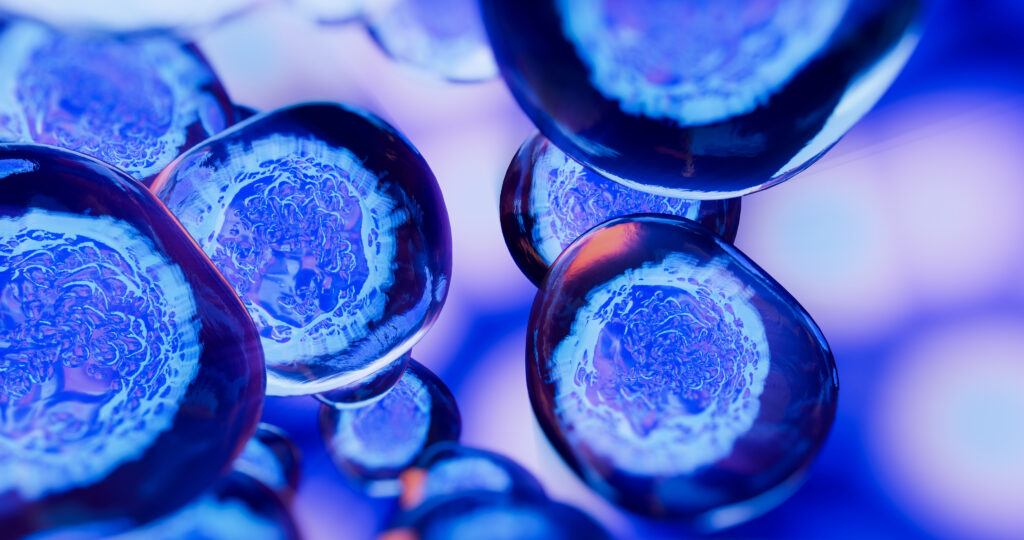
Cells produce proteins that serve different purposes in maintaining human health. These bioactive secretions range from growth factors to antibodies to cytokines and vary between different types of cells. Even within a certain cell type, however, there are individual cells that produce more secretions than others, a phenomenon that especially interests scientists studying cell-based therapies. In contrast to molecular therapies, which typically involve specific genes or proteins, a primary challenge to crafting cell therapies is the wide range of functional outputs seen in cells that have the same genetic template. This leads to the question of what molecular properties, from a genomic and transcriptomic perspective, would lead one cell to produce more of a protein than its companions.
There have been few investigative strategies put forth that allow scientists to connect a cell’s characteristics and genetic coding with its secretions. In July 2023 a team of scientists published a paper in Nature Communications outlining an innovative solution: little hydrogel particles, or “nanovials”, that essentially serve as tiny test tubes and can be used to measure protein secretion, track transcriptome data, and identify relevant surface markers in a single cell.
Introducing Nanovial Technology and SEC-seq
Techniques available for single-cell analysis each come with their own advantages, as well as key limitations that scientists in this study sought to overcome. Flow cytometry is acknowledged as the gold standard, with high quantitative resolution, sensitivity, and throughput. When paired with intracellular staining, this technique could be used to quantify secreted proteins in the context of surface markers. However, this method can also result in a loss of cell viability, hindering downstream transcriptomic analysis. Other techniques lack the resolution and multiplexing capabilities of flow cytometry, and none allow scientists to effectively link a cell’s genome, transcriptome, and surface markers with protein secretions.
Nanovials are microscopic hydrogel particles with bowl-shaped cavities that capture cells and can be lined with antibodies specific to a protein of interest. They are compatible with the multiplexing and high-throughput features of flow cytometry for identifying surface markers, are small enough to fit through the channels of a single-cell RNA-sequencing instrument, and allow for the quantification of protein secretions, all in one experiment. The researchers dubbed this method secretion-encoded single-cell sequencing (SEC-seq).
Applying SEC-seq to B Cell Populations
To demonstrate SEC-seq’s utility, researchers sought to screen B cells and measure the production of immunoglobin G, or IgG. In doing so, they hoped to identify key RNA sequences that they could use to engineer B cells to be more productive in B cell-based therapies. Scientists lined the nanovials with antibodies targeting IgG, captured the resulting secretions and ran the samples through flow cytometry and RNA-sequencing workflows.
From the ensuing analysis, scientists discovered surface markers associated with certain subpopulations of B cells that were seen to secrete high levels of IgG, including CD138 and CD59, among others. Scientists also noted that cell populations demonstrating high IgG secretion had transcripts in pathways tied to mitochondria respiration, protein transport, and translation. In theory, this method could advance our understanding of molecular signatures and secretion mechanisms in B cells, as well as other cell types, and directly link genetic and proteomic data to functional cellular outcomes.
Another study published December 2023 in Nature Nanotechnology detailed how scientists used SEC-seq to identify a distinct genetic signature, surface marker IL13RA2, correlated to the output of endothelial growth factor VEGF-A from mesenchymal stromal cells. These findings further demonstrated the precision of the technique and underscored its use in studying variable secretions between cells in a population.
Harnessing the power of SEC-seq and nanovial technology to study a cell’s secretions relative to its genetic and transcriptomic information could enable more targeted and effective cell therapies. Innovative strategies like this can help scientists better understand why certain cells are more productive than others, and how we can bring them to their highest therapeutic potential.
Sources:
Latest posts by AnnaKay Kruger (see all)
- Elephants May Call Each Other By Name - July 16, 2024
- Studying Episodic Memory through Food-Caching Behavior in Birds - April 16, 2024
- A Silent Killer: Tracking the Spread of Xylella fastidiosa - March 27, 2024
